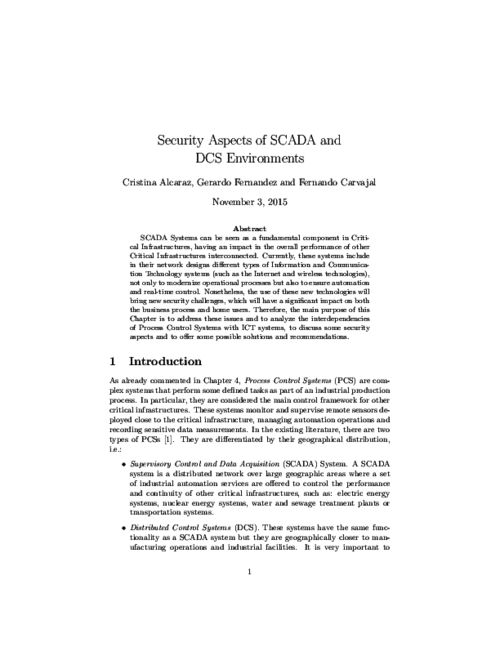 ]
] International Journal of Information Security, Springer, In Press. DOI
Abstract
Undoubtedly, Industry 4.0 in the energy sector improves the conditions for automation, generation and distribution of energy, increasing the rate of electric vehicle manufacturing in recent years. As a result, more grid-connected charging infrastructures are being installed, whose charging stations (CSs) can follow standardized architectures, such as the one proposed by the open charge point protocol (OCPP). The most recent version of this protocol is v.2.0.1, which includes new security measures at device and communication level to cover those security issues identified in previous versions. Therefore, this paper analyzes OCPP-v2.0.1 to determine whether the new functions may still be susceptible to specific cyber and physical threats, and especially when CSs may be connected to microgrids. To formalize the study, we first adapted the well-known threat analysis methodology, STRIDE, to identify and classify threats in terms of control and energy, and subsequently we combine it with DREAD for risk assessment. The analyses indicate that, although OCPP-v2.0.1 has evolved, potential security risks still remain, requiring greater protection in the future.
The 27th European Symposium on Research in Computer Security (ESORICS 2022), vol. 13555, Springer, Cham, pp. 716–736, 09/2022. DOI
Abstract
In recent years, the deployment of charging infrastructures has been increasing exponentially due to the high energy demand of electric vehicles, forming complex charging networks. These networks pave the way for the emergence of new unknown threats in both the energy and transportation sectors. Economic damages and energy theft are the most frequent risks in these environments. Thus, this paper aims to present a solution capable of accurately detecting unforeseen events and possible fraud threats that arise during charging sessions at charging stations through the current capabilities of the Machine Learning (ML) algorithms. However, these algorithms have the drawback of not fitting well in large networks and generating a high number of false positives and negatives, mainly due to the mismatch with the distribution of data over time. For that reason, a Collaborative Anomaly Detection System for Charging Stations (here referred to as CADS4CS) is proposed as an optimization measure. CADS4CS has a central analysis unit that coordinates a group of independent anomaly detection systems to provide greater accuracy using a voting algorithm. In addition, CADS4CS has the feature of continuously retraining ML models in a collaborative manner to ensure that they are adjusted to the distribution of the data. To validate the approach, different use cases and practical studies are addressed to demonstrate the effectiveness and efficiency of the solution.
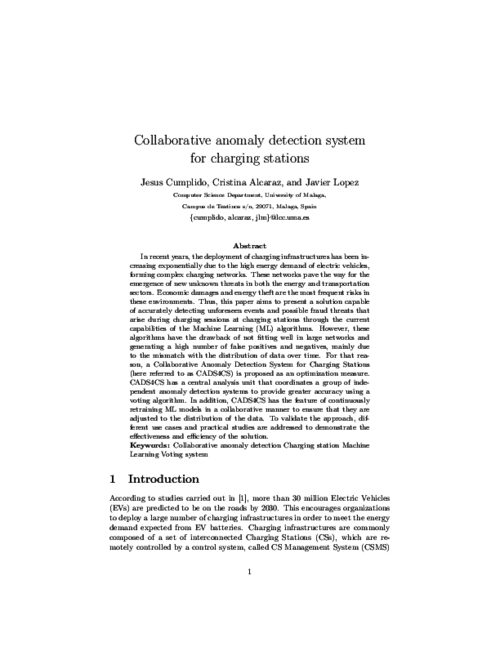
IEEE Systems Journal, vol. 12, issue 2, IEEE, pp. 1778-1792, 06/2018. DOI
Abstract
Current Critical Infrastructures (CIs) are complex interconnected industrial systems that, in recent years, have incorporated information and communications technologies such as connection to the Internet and commercial off-the-shelf components. This makes them easier to operate and maintain, but exposes them to the threats and attacks that inundate conventional networks and systems. This paper contains a comprehensive study on the main stealth attacks that threaten CIs, with a special focus on Critical Information Infrastructures (CIIs). This type of attack is characterized by an adversary who is able to finely tune his actions to avoid detection while pursuing his objectives. To provide a complete analysis of the scope and potential dangers of stealth attacks we determine and analyze their stages and range, and we design a taxonomy to illustrate the threats to CIs, offering an overview of the applicable countermeasures against these attacks. From our analysis we understand that these types of attacks, due to the interdependent nature of CIs, pose a grave danger to critical systems where the threats can easily cascade down to the interconnected systems.
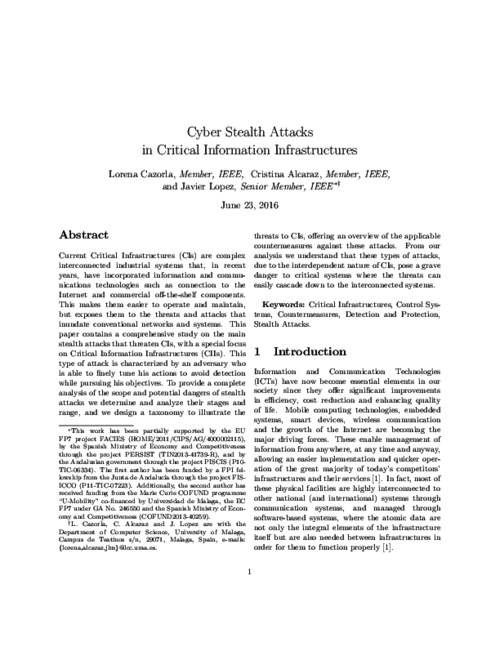
Cyber-Physical Systems: Foundations, Principles and Applications, no. Intelligent Data-Centric Systems, Academic Press, pp. 305 - 317, 2017. DOI
Abstract
Abstract Cyber-physical systems (CPSs), integrated in critical infrastructures, could provide the minimal services that traditional situational awareness (SA) systems demand. However, their application in SA solutions for the protection of large control distributions against unforeseen faults may be insufficient. Dynamic protection measures have to be provided not only to locally detect unplanned deviations but also to prevent, respond, and restore from these deviations. The provision of these services as an integral part of the SA brings about a new research field known as wide-area situational awareness (WASA), highly dependent on CPSs for control from anywhere across multiple interconnections, and at any time. Thus, we review the state-of-the art of this new paradigm, exploring the different preventive and corrective measures considering the heterogeneity of CPSs, resulting in a guideline for the construction of automated WASA systems.
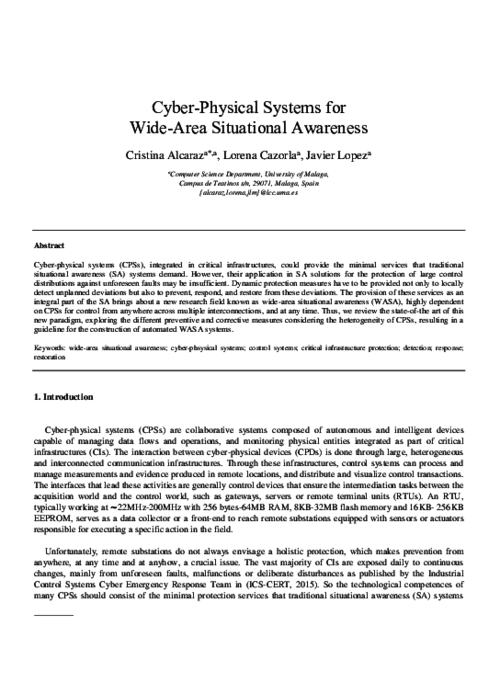
Computers & Security, vol. 71, Elsevier, pp. 2-14, 11/2017. DOI
Abstract
Secure interconnection between multiple cyber-physical systems has become a fundamental requirement in many critical infrastructures, where security may be centralized in a few nodes of the system. These nodes could, for example, have the mission of addressing the authorization services required for access in highlyrestricted remote substations. For this reason, the main aim of this paper is to unify all these features, together with the resilience measures so as to provide control at all times under a limited access in the field and avoid congestion. Concretely, we present here an optimal reachability-based restoration approach, capable of restoring the structural control in linear times taking into account: structural controllability, the supernode theory, the good practices of the IEC-62351 standard and the contextual conditions. For context management, a new attribute is specified to provide a more complete authorization service based on a practical policy, role and attribute-based access control (PBAC + RBAC + ABAC). To validate the approach, two case studies are also discussed under two strategic adversarial models.
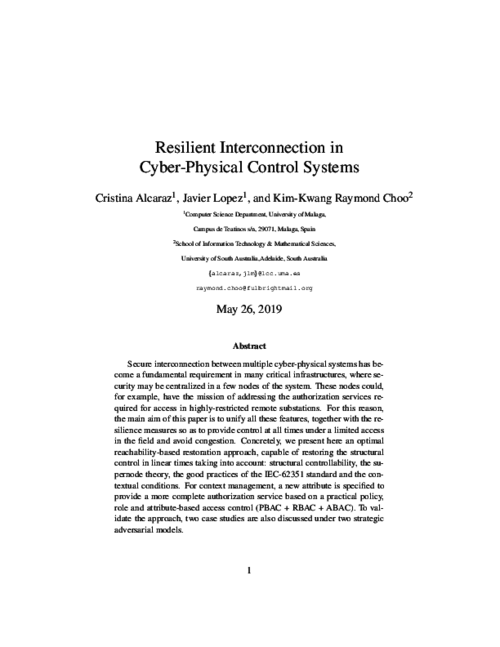
Proceedings of the 13th International Joint Conference on e-Business and Telecommunications (SECRYPT 2016), pp. 19-27, 2016. DOI
Abstract
Increasingly, automatic restoration is an indispensable security measure in control systems (e.g. those used in critical infrastructure sectors) due to the importance of ensuring the functionality of monitoring infrastructures. Modernizing the interconnection of control systems to provide interoperability between different networks, at a low cost, is also a critical requirement in control systems. However, automated recovery mechanisms are currently costly, and ensuring interoperability particularly at a low cost remains a topic of scientific challenge. This is the gap we seek to address in this paper. More specifically, we propose a restoration model for interconnected contexts, taking into account the theory of supernode and structural controllability, as well as the recommendations given by the IEC-62351-8 standard (which are mainly based on the implementation of a role-based access control system).
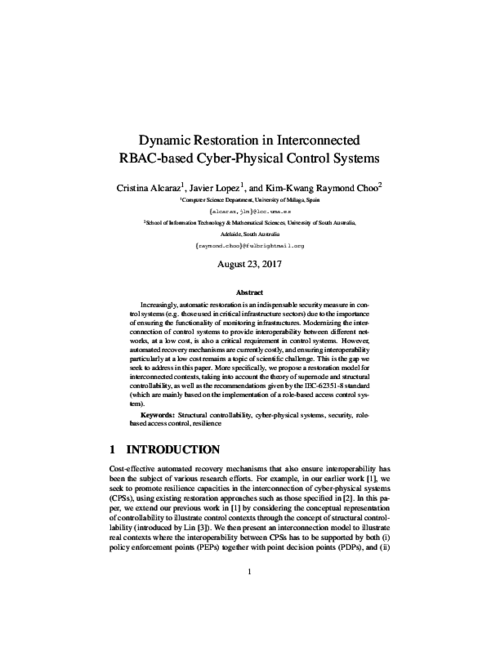
Computers and Electrical Engineering, vol. 47, issue October, Elsevier, pp. 299-317, 2015. DOI
Abstract
Current Critical Infrastructures (CIs) need intelligent automatic active reaction mechanisms to protect their critical processes against cyber attacks or system anomalies, and avoid the disruptive consequences of cascading failures between interdependent and interconnected systems. In this paper we study the Intrusion Detection, Prevention and Response Systems (IDPRS) that can offer this type of protection mechanisms, their constituting elements and their applicability to critical contexts. We design a methodological framework determining the essential elements present in the IDPRS, while evaluating each of their sub-components in terms of adequacy for critical contexts. We review the different types of active and passive countermeasures available, categorizing them and assessing whether or not they are suitable for Critical Infrastructure Protection (CIP). Through our study we look at different reaction systems and learn from them how to better create IDPRS solutions for CIP.
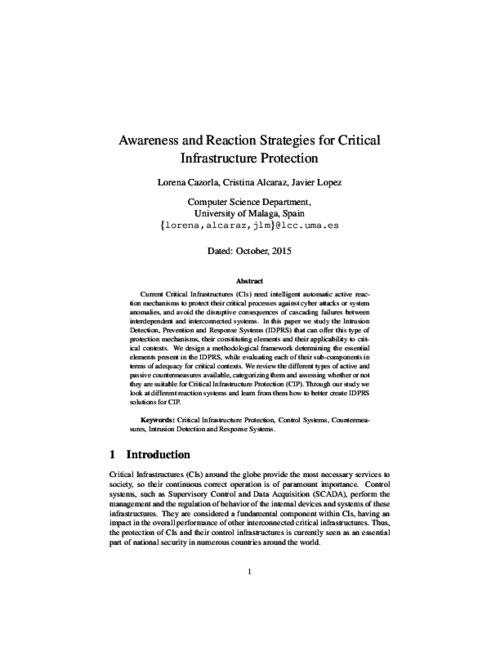
9th International Conference on Risks and Security of Internet and Systems , vol. 8924, Springer International Publishing, pp. 17-34, 04/2015. DOI
Abstract
Anomaly-based detection applied in strongly interdependent systems, like Smart Grids, has become one of the most challenging research areas in recent years. Early detection of anomalies so as to detect and prevent unexpected faults or stealthy threats is attracting a great deal of attention from the scientific community because it offers potential solutions for context-awareness. These solutions can also help explain the conditions leading up to a given situation and help determine the degree of its severity. However, not all the existing approaches within the literature are equally effective in covering the needs of a particular scenario. It is necessary to explore the control requirements of the domains that comprise a Smart Grid, identify, and even select, those approaches according to these requirements and the intrinsic conditions related to the application context, such as technological heterogeneity and complexity. Therefore, this paper analyses the functional features of existing anomaly-based approaches so as to adapt them, according to the aforementioned conditions. The result of this investigation is a guideline for the construction of preventive solutions that will help improve the context-awareness in the control of Smart Grid domains in the near future.
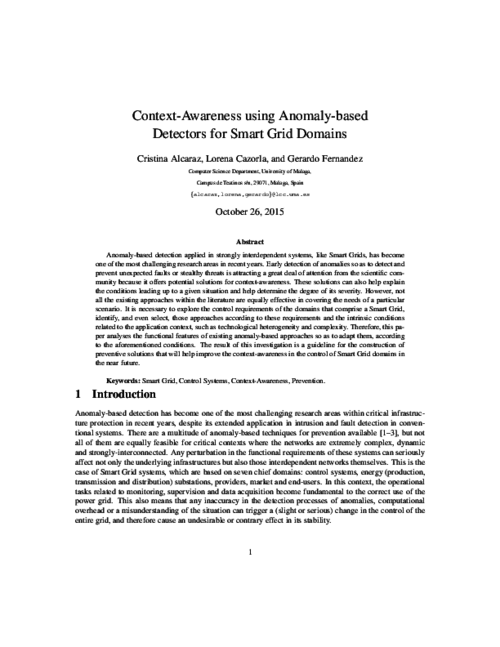
Computers & Security, vol. 55, no. November, Elsevier, pp. 235-250, 2015.
Abstract
The correct operation of Critical Infrastructures (CIs) is vital for the well being of society, however these complex systems are subject to multiple faults and threats every day. International organizations around the world are alerting the scientific community to the need for protection of CIs, especially through preparedness and prevention mechanisms. One of the main tools available in this area is the use of Intrusion Detection Systems (IDSs). However, in order to deploy this type of component within a CI, especially within its Control System (CS), it is necessary to verify whether the characteristics of a given IDS solution are compatible with the special requirements and constraints of a critical environment. In this paper, we carry out an extensive study to determine the requirements imposed by the CS on the IDS solutions using the Non-Functional Requirements (NFR) Framework. The outcome of this process are the abstract properties that the IDS needs to satisfy in order to be deployed within a CS, which are refined through the identification of satisficing techniques for the NFRs. To provide quantifiable measurable evidence on the suitability of the IDS component for a CI, we broaden our study using the Goal Question Metric (GQM) approach to select a representative set of metrics. A requirements model, refined with satisficing techniques and sets of metrics which help assess, in the most quantifiable way possible, the suitability and performance of a given IDS solution for a critical scenario, constitutes the results of our analysis.
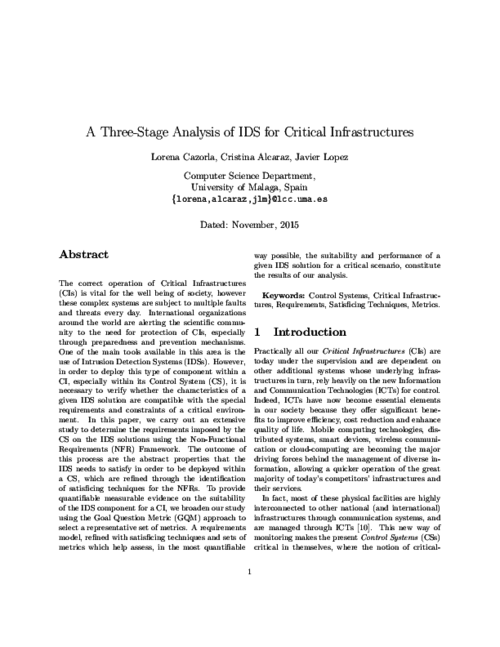
8th International Conference on Critical Information Infrastructures Security, vol. 8328, Springer, pp. 197-203, 2013. DOI
Abstract
Critical Infrastructure Protection (CIP) faces increasing challenges in number and in sophistication, which makes vital to provide new forms of protection to face every day’s threats. In order to make such protection holistic, covering all the needs of the systems from the point of view of security, prevention aspects and situational awareness should be considered. Researchers and Institutions stress the need of providing intelligent and automatic solutions for protection, calling our attention to the need of providing Intrusion Detection Systems (IDS) with intelligent active reaction capabilities. In this paper, we support the need of automating the processes implicated in the IDS solutions of the critical infrastructures and theorize that the introduction of Machine Learning (ML) techniques in IDS will be helpful for implementing automatic adaptable solutions capable of adjusting to new situations and timely reacting in the face of threats and anomalies. To this end, we study the different levels of automation that the IDS can implement, and outline a methodology to endow critical scenarios with preventive automation. Finally, we analyze current solutions presented in the literature and contrast them against the proposed methodology
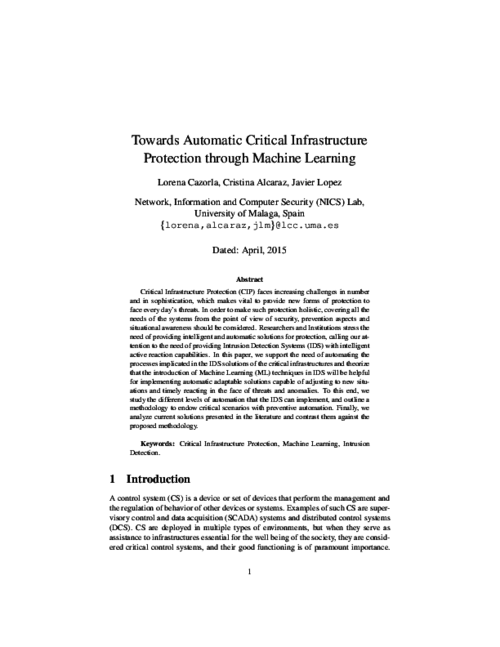
Critical Infrastructure Protection: Information Infrastructure Models, Analysis, and Defense, J. Lopez, S.. Wolthunsen, and R. Setola Eds., Advances in Critical Infrastructure Protection: Information Infrastructure Models, Analysis, and Defense. LNCS 7130. 7130, Springer-Verlag, pp. 120-149, September 2012.
Abstract
SCADA Systems can be seen as a fundamental component in Critical Infrastructures, having an impact in the overall performance of other Critical Infrastructures interconnected. Currently, these systems include in their network designs different types of Information and Communication Technology systems (such as the Internet and wireless technologies), not only to modernize operational processes but also to ensure automation and real-time control. Nonetheless, the use of these new technologies will bring new security challenges, which will have a significant impact on both the business process and home users. Therefore, the main purpose of this Chapter is to address these issues and to analyze the interdependencies of Process Control Systems with ICT systems, to discuss some security aspects and to offer some possible solutions and recommendations.
